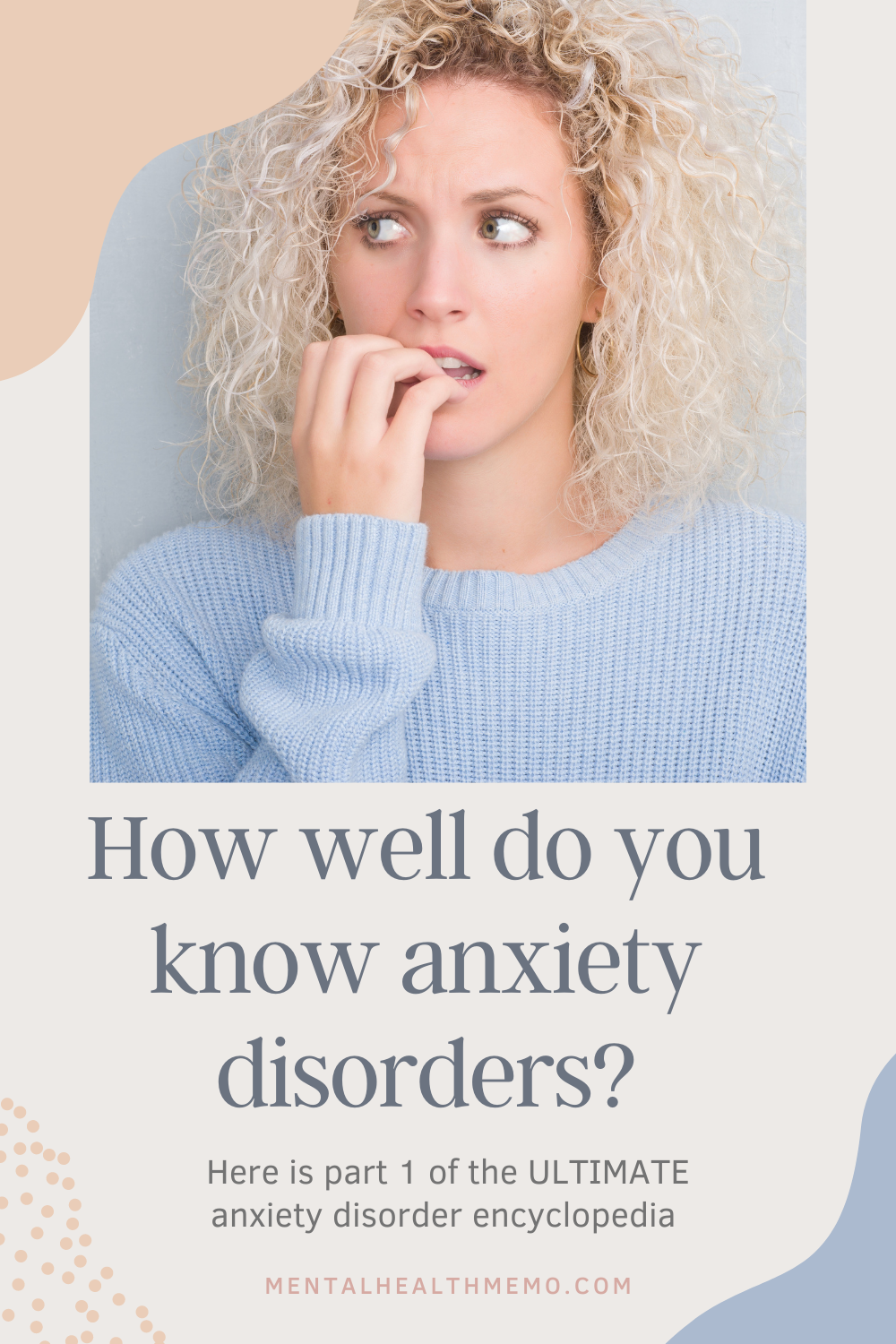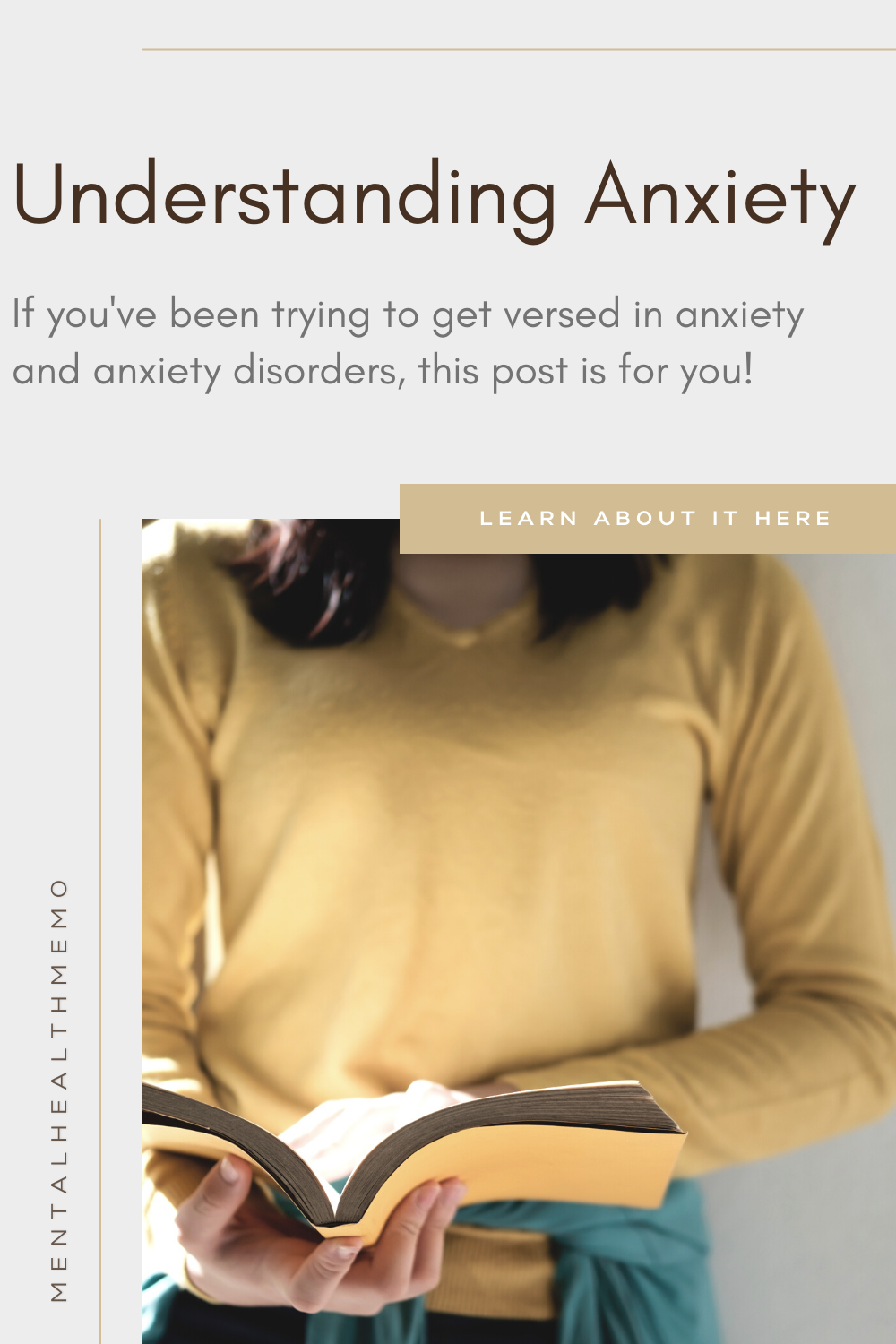Precursor:
Today’s mental health memo is: today we’re getting educational and psychological by learning about the different types of anxiety disorders that exist in this anxiety encyclopedia part 1 (click for part 2 here)
I wanted to create an outline of every single type of anxiety disorder because I feel like people often think anxiety is just one thing. Many might assume anxiety to look like a person that is often worried, or perhaps has panic attacks, or is often nervous. And while that does apply to some anxiety disorders and symptoms, that is certainly not the whole story.
Anxiety is a shapeshifter that comes forth in all types of thoughts, compulsions, and behaviors.
I think this guide is helpful if you’re trying to understand anxiety disorders or are concerned that you may have one. However, please do not self-diagnose yourself based on this or other similar articles.
If you think you have one of these disorders, talk your health care provider to figure out a diagnosis and treatment plan. I am not a health professional. My article is based on the DSM-5, my personal experiences with anxiety and my studies in Social Work and Psychology.
If you’re interested in further studying mental health disorders, I recommend purchasing the DSM-5 and doing some reading up. However, please do note that this is a book meant to be used by Psychiatrists, Psychologists, and other mental health professionals for diagnostic purposes. It’s not a casual “self-help” book nor is it meant for you to use if you are not licensed.
As a Social Worker, I have looked through it as I am in a field that would benefit from that knowledge even though I can’t diagnose anyone. I also read it out of interest since I’m highly passionate about mental health. But, I know where my limitations stand with the book and so should you.

If you’re from the U.S, buy me here 🙂
If you’re from Canada, buy me here 🙂
This post is going to be part one of a two-part series because there are simply so many anxiety disorders out there. Even with a two-part series, I won’t be able to cover every single anxiety disorder out there, though I will go over some of the most common ones.
With so much to cover on our plate, let’s jump in!
*This post may contain affiliate links. By using the links on this article, I get a small amount of commission that I put back into my blog and Youtube channel. This does not compromise my integrity and I only recommend things I actually believe in or find of good quality. You do not get charged extra by using these links. Thanks for supporting my content if you end up using these links :)*

What are Anxiety Disorders?
We all feel anxiety to an extent. Perhaps before a job interview, a first date, when we have a lot on our plates. And believe it or not, anxiety is actually good for us. It triggers our Sympathetic Nervous System which inevitably sharpens our focus through stimulating our adrenaline. Anxiety can also act as a motivator, a reason for meeting a deadline, and it can even protect us.
The issue, just like other mental illnesses, is when the feelings of anxiety become permanent, consistent, and debilitating. Essentially, we are feeling excessive anxiety.
I made a video about how to know if you have a mental illness and the different models around diagnosing if you’re interested in better understanding how regular emotions differ from a mental disorder.
Anxiety disorders are also very common. Many surveys have indicated that around 33.7% of the population experiences an anxiety disorder at some point in their lifetime.
We also know that they are treatable, and there are many treatment plans available for people struggling with anxiety.
With a better understanding of anxiety and what an anxiety disorder is, let’s get into the variants!
1. Generalized Anxiety Disorder
Worrying about things is a very natural human thing to do. It becomes GAD when the anxiety is happening too often and to serious extremes.
GAD is essentially feeling worried and anxious about everything all the time. Perhaps the disorder that fits the stereotype of anxiety the most.
A lot of GAD anxiety comes from “what if’s”.
- What if my family member gets into an accident on the way home?
- Or what if I fail this test and then I fail the course and then I fail my program and then I can’t get a job and then I fail at life?
- Do they hate me?
- What if I don’t buy this thing now and then it’s going to disappear forever and I’ll regret it?
And as mentioned, it’s normal for us to worry like this to some extent.
But GAD is when this anxiety is happening all the time, to often unrealistic extremes, and is accompanied by physical symptoms.
Physical Symptoms + Treatment:
Physical symptoms are what you would expect with anxiety: fatigue, trouble sleeping, heart racing, sweating, changes in appetite etc.
It’s very possible to also experience anxiety attacks or panic attacks with GAD (anxiety attacks and panic attacks are not the same thing FYI). But unlike with Panic Disorder, the anxiety/panic attack is due to a stressor (more on this shortly).
Often Cognitive Behavioural Therapy is used for helping those with GAD, and potentially anti-anxiety and/or anti-depressive medications.
Of course there are other types of psychotherapy that can be provided and may be of better use to you. This can be said for all the other disorders on the list.
However, I’m simply providing the most common and evidence-based ones.
2. Panic Disorder
In simplest terms, Panic Disorder is described by reoccurring and unexpected panic attacks. It starts when an individual has a panic attack that triggers the disorder. In other words, you can’t just have Panic Disorder out of the blue. You need to have a panic attack first to trigger it.
What is a panic attack you ask? Great question! I’ve answered that in detail in my video below 🙂
Once this happens, the person then starts being incredibly anxious due to fear of having another panic attack. They may be worried about what’ll happen to them if they have one (die, go crazy, faint, embarrass themselves).
All this anxiety then elicits another panic attack, and the cycle keeps going. To better illustrate this here is the sequence of events:
Panic attack that triggers Panic Disorder -> Anxiety over having another panic attack -> Panic attack ->More anxiety -> Another panic attack
As previously mentioned, a person first needs to have a panic attack to trigger the Panic Disorder. But this happens only to certain individuals that have a predisposition to have that response.
Meaning, they have either genetic or environmental factors that when combined, make them vulnerable for developing Panic Disorder if they get a panic attack.
This can be things like a traumatic childhood, anxiety as a child, mental illness (especially anxiety) in the family, or something else.
Another thing to note is that not everyone who has a panic attack will develop Panic Disorder. Most people experience anxiety and panic attacks throughout their lives but don’t develop the disorder.
Physical Symptoms + Treatment:
Many of the long-term physical symptoms of Panic Disorder are similar to GAD (most anxiety disorders will have a similar list), but the difference is that the body is often more exhausted with Panic Disorder due to the sheer quantity of panic attacks that happen.
If you weren’t aware, panic attacks are absolutely draining and devastating to the body because they trigger your “Fight, Flight, Freeze” responses; one of the most primitive survival instincts we have.
Also, one of the most taxing instincts we have as it’s associated with simply getting out alive (even if there is nothing to actually get out alive from- aka why this is a disorder).
CBT, Exposure Therapy, and medication are common treatments in the medical world. Of course, things like exercise, proper sleep, a healthy diet, and good support systems also play an integral role in recovery (just as with all other mental health disorders).
Comparing GAD and Panic Disorder
I previously mentioned that GAD panic/anxiety attacks are caused by a stressor. A stressor is something that caused you a great deal of distress and triggered the attack. For example, a very heavy workload.
With Panic Disorder though, there doesn’t necessarily need to be a stressor. While there certainly can be, it’s not a requirement. That is where the “unexpected” part of the disorder description comes into play.
In fact, panic attacks can be so unexpected in Panic Disorder they can even happen during the night when the individual is a sleep. This is known as a nighttime or nocturnal panic attack.
So, panic/anxiety attacks for GAD are often based on a stressor. Panic attacks for Panic Disorder are often unexpected (though you can be triggered).
3. Agoraphobia
I put Agoraphobia after Panic Disorder because they’re like 2 peas in a pod.
Agoraphobia is the intense phobia of going to places or doing things that will likely elicit a panic attack. This goes hand in hand with Panic Disorder due the high amounts of panic attacks associated with it.
The tricky part with Agoraphobia is that it’s a slippery slope that leads you to complete isolation.
I’ll explain this with an example from my own life (I have Panic Disorder with Agoraphobia):
First, I started being too anxious to go back to school because it’s where I had my initial panic attack which triggered my Panic Disorder. So I started avoiding school in fear of having a panic attack there.
But then, because I had such high levels of anxiety, I inevitably ended up having a panic attack on the bus. Thus, I stopped taking buses.
After that I had a panic attack going to a friend’s house, and so I stopped going to see my friends.
Eventually, I ended up having panic attacks no matter where I went and I refused to leave my house entirely.
You can see how this avoidance can lead you to severe impairment and isolation, which is why it’s so important to treat it.
Physical Symptoms + Treatment:
Again, Agoraphobia’s physical symptoms will match pretty closely to that of other disorders.
The way to treat it is often through Exposure Therapy, CBT, and medication. I personally used Exposure Therapy and CBT and I’ve been able to return to relatively regular life now despite still having Agoraphobia!
And just to be a repetitive robot, taking care of your general wellbeing and other holistic approaches may be helpful too, I’m just focusing on the medical end of things in this post.
4. Obsessive-Compulsive Disorder
Obsessions are negative thoughts that elicit anxiety in the person experiencing them. This can be in relation to contamination, losing control of oneself, balance, sexual desires, offending God, and many more.
So an example would be “What if someone enters my house because I didn’t lock it and murders my family?”.
The compulsion is the action this person does (a ritual) to appease that anxiety. In this case, the person could potentially re-lock their door 7 times before they feel satisfied that their obsessive thought won’t happen.
And they do this for every lock, every day. 7 times each time.
The thought of locking the house for security makes sense, but the problem is when it’s taken to an extreme.
For a person with OCD, they need to do appease their ritual otherwise they’ll think their obsessive thought (which is usually bad and scary) will happen.
This creates high levels of anxiety for the person, so you can imagine why they can’t simple stop their obsessions or compulsions.
Here are some more examples of obsessions and compulsions to clear it up:
- Everything around me is dirty and I feel contaminated when I touch it, so I clean my house for 3 hours every single day.
- If my body doesn’t feel balanced something bad is going to happen. I’m not sure what, but I know that it will. So, everything I do with the right side of my body I’m going to do with the left to maintain this balance and prevent this bad event
- I’m scared that I’m going to push this person into the train tracks in front of me even though I know I’m a good person and I don’t want to, so I’m going to count until 100 in my head until it stops.
As you can guess, it’s incredibly difficult to go through life with these types of intrusive thoughts. It’s also incredibly hard to maintain certain rituals due to how long they take to complete.
Physical Symptoms + Treatment:
Physical symptoms will match those of other anxiety disorders but depending on the ritual of the person, other symptoms may occur. For example, if one is cleaning often they may start having respiratory issues, headaches, or skin problems from the chemicals in the products.
OCD is typically treated with Exposure Therapy and medication. Often times CBT can be helpful too.
I want to make a final note on the media representation of OCD. The disorder is not all about organization and cleanliness and you’re not being quirky by calling yourself that simply because you’re a neat freak. It is a very real disorder that heavily impacts peoples’ lives and this needs to be respected.

In Summary
I hope you have found this article resourceful and learned something new about an anxiety disorder or two! If you have any questions or concerns about a potential diagnosis for yourself, please reach out to your health care provider. Do NOT self-diagnosing.
What was one thing you learned about anxiety disorders from this post? I’d love to know! Let me know in the comments below 🙂
All my love,
T

